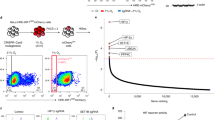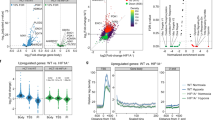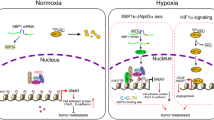Abstract
Chronic hypoxia, a hallmark of many tumors, is associated with angiogenesis and tumor progression. Strategies to treat tumors have been developed in which tumor cells are targeted with drugs or gene-therapy vectors specifically activated under hypoxic conditions. Here we report a different approach, in which the normal transcriptional response to hypoxia is selectively disrupted. Our data indicate that specific blockade of the interaction of hypoxia-inducible factor with the CH1 domain of its p300 and CREB binding protein transcriptional coactivators leads to attenuation of hypoxia-inducible gene expression and diminution of tumor growth. Thus, disrupting the normal co-activational response to hypoxia may be a new and useful therapeutic strategy.
This is a preview of subscription content, access via your institution
Access options
Subscribe to this journal
Receive 12 print issues and online access
$209.00 per year
only $17.42 per issue
Buy this article
- Purchase on Springer Link
- Instant access to full article PDF
Prices may be subject to local taxes which are calculated during checkout





Similar content being viewed by others
References
Semenza, G.L. Regulation of mammalian O2 homeostasis by hypoxia-inducible factor 1. Annu. Rev. Cell. Dev. Biol. 15, 551–578 (1999).
Wang, G.L., Jiang, B.H., Rue, E.A. & Semenza, G.L. Hypoxia-inducible factor 1 is a basic-HLH-PAS heterodimer regulated by cellular O2 tension. Proc. Natl. Acad. Sci. USA 92, 5510–5514 (1995).
Salceda, S. & Caro, J. HIF-1α protein is rapidly degraded by the ubiquitin-proteasome system under normoxic conditions. Its stabilization by hypoxia depends on redox-induced changes. J. Biol. Chem. 272, 22642–22647 (1997).
Huang, L.E., Arany, Z., Livingston, D.M. & Bunn, H.F. Activation of HIF depends primarily upon redox-sensitive stabilization of its α subunit. J. Biol. Chem. 271, 32253–32259 (1996).
Maxwell, P.H. et al. The tumour suppressor protein VHL targets hypoxia-inducible factors for oxygen-dependent proteolysis. Nature 399, 271–275 (1999).
Cockman, M.E. et al. HIF-α binding and ubiquitylation by the von Hippel-Lindau tumor suppressor protein. J. Biol. Chem. 275, 25733–25741 (2000).
Ohh, M. et al. Ubiquitination of hypoxia-inducible factor requires direct binding to the β-domain of the von Hippel-Lindau protein. Nature Cell Biol. 2, 423–427 (2000).
Jiang, B.H., Semenza, G.L., Bauer, C. & Marti, H.H. HIF-1 levels vary exponentially over a physiologically relevant range of O2 tension. Am. J. Physiol. 271, C1172–1180 (1996).
Jiang, B.H., Rue, E., Wang, G.L., Roe, R. & Semenza, G.L. Dimerization, DNA binding, and transactivation properties of HIF-1. J. Biol. Chem. 271, 17771–17778 (1996).
Arany, Z. et al. An essential role for p300/CBP in the cellular response to hypoxia. Proc. Natl. Acad. Sci. USA 93, 12969–12973 (1996).
Ebert, B.L. & Bunn, H.F. Regulation of transcription by hypoxia requires a multiprotein complex that includes HIF-1, an adjacent transcription factor, and p300/CREB binding protein. Mol. Cell. Biol. 18, 4089–4096 (1998).
Kallio, P.J. et al. Signal transduction in hypoxic cells: inducible nuclear translocation and recruitment of the CBP/p300 co-activator by the HIF-1α. EMBO J. 17, 6573–6586 (1998).
Carrero, P. et al. Redox-regulated recruitment of the transcriptional co-activators CREB-binding protein and SRC-1 to HIF-1α. Mol. Cell. Biol. 20, 402–415 (2000).
Semenza, G.L. & Wang, G.L. A nuclear factor induced by hypoxia via de novo protein synthesis binds to the human erythropoietin gene enhancer at a site required for transcriptional activation. Mol. Cell. Biol. 12, 5447–5454 (1992).
Nordsmark, M., Bentzen, S.M. & Overgaard, J. Measurement of human tumour oxygenation status by a polarographic needle electrode. An analysis of inter- and intratumour heterogeneity. Acta Oncol. 33, 383–389 (1994).
Helmlinger, G., Yuan, F., Dellian, M. & Jain, R.K. Interstitial pH and pO2 gradients in solid tumors in vivo: high-resolution measurements reveal a lack of correlation. Nature Med. 3, 177–182 (1997).
Brown, J.M. Exploiting the hypoxic cancer cell: mechanisms and therapeutic strategies. Mol. Med. Today. 6, 157–162 (2000).
Shweiki, D., Itin, A., Soffer, D. & Keshet, E. Vascular endothelial growth factor induced by hypoxia may mediate hypoxia-initiated angiogenesis. Nature 359, 843–845 (1992).
Zhong, H. et al. Overexpression of HIF-1α in common human cancers and their metastases. Cancer Res. 59, 5830–5835 (1999).
Hockel, M. et al. Association between tumor hypoxia and malignant progression in advanced cancer of the uterine cervix. Cancer Res. 56, 4509–4515 (1996).
Brizel, D.M. et al. Tumor oxygenation predicts for the likelihood of distant metastases in human soft tissue sarcoma. Cancer Res. 56, 941–943 (1996).
Zeman, E. M., Brown, J. M., Lemmon, M. J., Hirst, V. K. & Lee, W. W. SR-4233: a new bioreductive agent with high selective toxicity for hypoxic mammalian cells. Int. J. Radiat. Oncol. Biol. Phys. 12, 1239–1242 (1986).
Binley, K., Iqball, S., Kingsman, A., Kingsman, S. & Naylor, S. An adenoviral vector regulated by hypoxia for the treatment of ischaemic disease and cancer. Gene Ther. 6, 1721–1727 (1999).
Shibata, T., Giaccia, A.J. & Brown, J.M. Development of a hypoxia-responsive vector for tumor-specific gene therapy. Gene Ther. 7, 493–498 (2000).
Jiang, B.H., Zheng, J.Z., Leung, S.W., Roe, R. & Semenza, G.L. Transactivation and inhibitory domains of HIF-1α. Modulation of transcriptional activity by oxygen tension. J. Biol. Chem. 272, 19253–19260 (1997).
Wilson, I. A. et al. Identical short peptide sequences in unrelated proteins can have different conformations: a testing ground for theories of immune recognition. Proc. Natl. Acad. Sci. USA 82, 5255–5259 (1985).
Chakravarti, D. et al. Role of CBP/P300 in nuclear receptor signalling. Nature 383, 99–103 (1996).
Oliner, J.D., Andresen, J.M., Hansen, S.K., Zhou, S. & Tjian, R. SREBP transcriptional activity is mediated through an interaction with the CREB-binding protein. Genes Dev. 10, 2903–2911 (1996).
Yao, T.P., Ku, G., Zhou, N., Scully, R. & Livingston, D.M. The nuclear hormone receptor co-activator SRC-1 is a specific target of p300. Proc. Natl. Acad. Sci. USA 93, 10626–10631 (1996).
Bhattacharya, S. et al. Cooperation of Stat2 and p300/CBP in signalling induced by interferon-α. Nature 383, 344–347 (1996).
Carmeliet, P. et al. Role of HIF-1α in hypoxia-mediated apoptosis, cell proliferation and tumour angiogenesis. Nature 394, 485–490 (1998).
Ryan, H.E., Lo, J. & Johnson, R.S. HIF-1α is required for solid tumor formation and embryonic vascularization. EMBO J 17, 3005–3015 (1998).
Maxwell, P.H. et al. HIF-1 modulates gene expression in solid tumors and influences both angiogenesis and tumor growth. Proc. Natl. Acad. Sci. USA 94, 8104–8109 (1997).
Ryan, H.E. et al. HIF-1α is a positive factor in solid tumor growth. Cancer Res. 60, 4010–015 (2000).
Zhong, H. et al. Modulation of HIF-1α expression by the epidermal growth factor/phosphatidylinositol 3-kinase/PTEN/AKT/FRAP pathway in human prostate cancer cells: implications for tumor angiogenesis and therapeutics. Cancer Res. 60, 1541–1545 (2000).
Zundel, W. et al. Loss of PTEN facilitates HIF-1-mediated gene expression. Genes Dev. 14, 391–396 (2000).
Jiang, B.H., Rue, E., Wang, G.L., Roe, R. & Semenza, G.L. Dimerization, DNA binding, and transactivation properties of HIF-1. J. Biol. Chem. 271, 17771–17778 (1996).
Kamei, Y. et al. A CBP integrator complex mediates transcriptional activation and AP-1 inhibition by nuclear receptors. Cell 85, 403–414 (1996).
Horvai, A.E. et al. Nuclear integration of JAK/STAT and Ras/AP-1 signaling by CBP and p300. Proc. Natl. Acad. Sci. USA 94, 1074–1079 (1997).
Foster, B.A., Coffey, H.A., Morin, M.J. & Rastinejad, F. Pharmacological rescue of mutant p53 conformation and function. Science 286, 2507–2510 (1999).
Olumi, A.F. et al. Carcinoma-associated fibroblasts direct tumor progression of initiated human prostatic epithelium. Cancer Res. 59, 5002–5011 (1999).
Fukumura, D. et al. Tumor induction of VEGF promoter activity in stromal cells. Cell 94, 715–725 (1998).
Ausubel, F.M. et al. (eds.) Current Protocols in Molecular Biology (Wiley-Interscience, New York, 1988).
LaVallie, E.R. et al. A thioredoxin gene fusion expression system that circumvents inclusion body formation in the E. coli cytoplasm. Biotechnology (NY) 11, 187–193 (1993).
Bhattacharya, S. et al. Functional role of p35srj, a novel p300/CBP binding protein, during transactivation by HIF-1. Genes Dev. 13, 64–75 (1999).
Acknowledgements
We thank R. Mulligan for retroviral vectors; and L. Sambucetti, S. Zabludoff, D. France and S. Bhattacharya for their advice. This work was supported by grants from the Novartis/DFCI Drug Discovery Program (to D.M.L.), and the Howard Hughes Medical Institute (to A.L.K. and W.G.K.).
Author information
Authors and Affiliations
Corresponding author
Rights and permissions
About this article
Cite this article
Kung, A., Wang, S., Klco, J. et al. Suppression of tumor growth through disruption of hypoxia-inducible transcription. Nat Med 6, 1335–1340 (2000). https://doi.org/10.1038/82146
Received:
Accepted:
Issue Date:
DOI: https://doi.org/10.1038/82146
This article is cited by
-
NOX4: a potential therapeutic target for pancreatic cancer and its mechanism
Journal of Translational Medicine (2021)
-
An in vitro tumorigenesis model based on live-cell-generated oxygen and nutrient gradients
Communications Biology (2021)
-
The HIF complex recruits the histone methyltransferase SET1B to activate specific hypoxia-inducible genes
Nature Genetics (2021)
-
Targeting hypoxia-inducible factor 1 (HIF-1) signaling with natural products toward cancer chemotherapy
The Journal of Antibiotics (2021)
-
Comparison of In Vitro Chlamydia muridarum Infection Under Aerobic and Anaerobic Conditions
Current Microbiology (2020)



